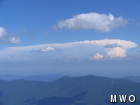National Lightning Safety Awareness Week
2009-06-21 17:07:33.000 – Brian Clark, Observer and Meteorologist
A distand thunderstorm – Summer 2007
Today marks the beginning of National Lightning Safety Awareness Week. Obviously as a scientific organization that mainly deals with weather as well as an organization that works to educate the public as part of our mission, spreading the word about lightning safety is very important.
In general, the National Weather Service has slightly changed their stance on lightning safety in the outdoors, now saying that NO place outdoors is safe. At the same time, they do continue to offer some suggestions on how to make your exposure a LITTLE less dangerous. Here are a few highlights:
– Do not seek shelter under tall isolated trees. The tree may help you stay dry but may increase your risk of being struck by lightning. Rain will not kill you, but the lightning can!
– Do not seek shelter under partially enclosed buildings
And lastly, one that I found particularly interesting and would be extremely valuable for the climbing community:
– Wet ropes can make excellent conductors. This is BAD news when it comes to lightning activity. If you are mountain climbing and see lightning, and can do so safely, remove unnecessary ropes extended or attached to you. If a rope is extended across a mountain face and lightning makes contact with it, the electrical current will likely travel along the rope, especially if it is wet.
Remarkably, no one has died from a lightning strike on Mount Washington. However, there have been close calls on Mount Washington and on Mount Chocorua; in the White Mountains, the Franconia Ridge has seen a lightning fatality, and elsewhere in New England, Maine’s Katahdin has claimed at least one life through lightning. Given the number of visitors to Mount Washington, and the fact that thunderstorms – some brief, some lasting hours – occur with some regularity, personal vigilance is required to maintain safety. Checking the forecast before a hiking trip, especially to the above treeline regions, should be a standard practice. When thunderstorms threaten, staying below treeline, and ideally INDOORS should be your plan. But don’t rely on the forecast alone. Keep attuned to the weather that is occurring around you, and to clouds building on the horizon. Head down below treeline, and ideally to bonafide shelter (a substantial building or a suitable vehicle) at the first sign of an approaching thunderstorm.
For more information check out the National Weather Service’s website!
Brian Clark, Observer and Meteorologist
Team Flags Return for Seek the Peak’s 25th Anniversary
Team Flags Return for Seek the Peak's 25th Anniversary By MWOBS Staff Mount Washington Observatory is looking forward to continuing a much-loved tradition for Seek the Peak’s 25th Anniversary: Team flags. In inviting teams
Meet Summer Interns Zakiya, Max and Maddie
Meet Summer Interns Zakiya, Max and Maddie By MWOBS Staff We are excited to welcome six teammates to the summit of Mount Washington this summer! During their internship, these students and graduates will play
Saying Goodbye to the Summit
Saying Goodbye to the Summit By Alexis George After an extraordinary last three years working as a Weather Observer and Meteorologist, I am excited to pursue a different career. As sad I as am






